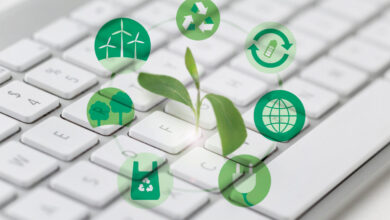Greening The Workplace: 5 Tips For Designing An Eco-Friendly Office Space

Explore the various aspects of eco-friendly office design and the transformative impact it can have on the workplace.
In an era marked by a growing concern for the environment and sustainability, the concept of eco-friendly office design has gained significant prominence. As companies increasingly recognize the need to reduce their carbon footprint and demonstrate a commitment to sustainability, the design of office spaces is evolving to meet these goals.
Here are some valuable and mindful sustainable office design ideas.
Energy-Efficient Lights
Opting for LED lighting instead of traditional incandescent bulbs is a prudent choice. LED lights consume less energy and offer high energy efficiency, with the added benefit of coming in various shapes, colors, and sizes.
Additionally, intelligent HVAC systems are designed to detect usage patterns and automatically adjust temperature settings, resulting in decreased energy consumption. The increasing prominence of solar energy presents a viable and cost-effective long-term solution. Installing solar panels on your terrace enables the harnessing of clean energy for your office space.
Sustainable Materials
Employing sustainable materials in the construction of your office space contributes to both environmental preservation and cost-effectiveness. Opting for materials that are sustainable and recyclable is a practical choice. Alternatively, if recyclable options are not readily available, you can select materials that are sustainably sourced, thereby mitigating their environmental impact during production.
Another eco-conscious option is the use of materials such as bamboo, cork, and rattan, which not only exude a natural and aesthetically pleasing appeal but also align with sustainable practices. Notably, sustainable materials are characterized by their low levels of VOCs (volatile organic compounds) and harmful chemicals, which can have adverse effects on indoor air quality.
Water Conservation
In the pursuit of creating a sustainable office design, effective water conservation practices can significantly contribute to maintaining an eco-friendly environment. To reduce water consumption, consider the installation of low-flow fixtures in toilets, urinals, and faucets.
Introducing greywater recycling is another sustainable measure, where water from sinks and showers is reused for toilet flushing. In regions with abundant rainfall, the implementation of rainwater harvesting provides a valuable strategy for water conservation, enabling the collection and utilization of rainwater.
Don’t overlook the importance of leak detection systems, as they swiftly identify plumbing issues, thereby minimizing water wastage — a crucial step toward creating a more environmentally conscious workplace.
Breathe In With Good Air Quality
Maintaining high indoor air quality is a fundamental aspect of daily office operations and is seamlessly integrated into the sustainable design of the workspace. You can enhance ventilation by opening windows, facilitating cross-ventilation, and employing both natural and mechanical air purification systems.
In addition, it’s prudent to avoid the use of chemical cleaners and air fresheners that contain VOCs (volatile organic compounds). To regulate and control office humidity levels, consider the use of dehumidifiers.
Furthermore, an effortless and highly effective approach is to incorporate a profusion of indoor and outdoor planters throughout the office environment. These plants serve as natural air purifiers, contributing to the improved breathing quality for you and your team.
Utilizing Natural Light

Introducing ample natural light into your workspace can have a positive impact on your employees’ morale and vitality. Furthermore, the installation of expansive windows that allow daylight to flood not only leads to reduced electricity expenses but also enhances employee productivity. For areas located far from exterior walls, contemplate the use of large windows, skylights, or light tunnels to maximize the infusion of natural light.
The Benefits of Eco-Friendly Office Design
Environmental Impact
Eco-friendly office design significantly reduces a company’s environmental footprint. By conserving energy, water, and resources, and by minimizing waste and emissions, these designs contribute to a more sustainable and responsible approach to the built environment.
Improved Employee Well-being
Studies have shown that eco-friendly office spaces can have a positive impact on employee well-being. Access to natural light, greenery, and clean air can reduce stress, boost mood, and enhance overall job satisfaction.
Enhanced Productivity
A well-designed eco-friendly office can lead to increased productivity. Natural lighting, comfortable temperatures, and ergonomic furniture all contribute to a more comfortable and inviting workspace, which can motivate employees to work more efficiently.
Cost Savings
While the initial investment in eco-friendly office design may be higher, the long-term cost savings are substantial. Lower energy bills, reduced maintenance expenses, and fewer employee sick days due to improved indoor air quality all contribute to significant financial benefits.
Conclusion
Eco-friendly office design represents a significant step forward in shaping the future of workspaces. It not only aligns with the growing global focus on environmental sustainability but also offers a plethora of benefits, from improved employee well-being and increased productivity to cost savings.
With its pioneering climate action platform, The Disposal Company is leading the charge towards a sustainable future in India, enabling brands to go plastic-neutral and carbon-neutral with ease. Discover more here.




